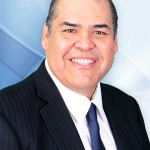ESCONDIDO — A familiar face versus the pastor.
In the run-up to Tuesday’s city council election for District 3, incumbent Olga Diaz seeks her third term, but must fend off challenger Joe Garcia.
It is also the first time Diaz is running in a district race, which was implemented two years ago after a California voting rights lawsuit.
Diaz is the lone Democrat, and self-described bleeding heart, liberal, feminist and Latina on the council and is often on the losing end of 4-1 votes of the conservative majority. However, she takes pride in offering different viewpoints, although she said it’s not just to disagree for the sake of it or due to straight political ideological differences.

Diaz said she wants to make the best decision possible, which is why she pours through every document crossing her desk relating to city matters.
However, she did take a hit politically two years ago when she was crushed in the mayor’s race by Sam Abed. Still, she is up for the challenge and with no serious alternative, Diaz opted to run for another term.
“I wasn’t going to run for re-election,” she said. “I was waiting for a strong candidate to run, and I didn’t see that. I know how to do the work. It’s manageable to do the work.”
Garcia, meanwhile, is an admittedly moderate conservative who has been a pastor for the past 28 years. His work has put him through all types of situations, but he said deciding to run for council was one of the most difficult.
Garcia said after he was approached by Abed to run, he took time to pray to God for a clear sign. Once Garcia saw the sign, he went all in and has been working toward ousting the veteran Diaz.
Perhaps the most difficult challenge for Garcia, he said, is fundraising, which means asking people for money. He’s raised more than $20,000, but another obstacle is overcoming Diaz’s experience of city operations and issues. Plus, she has raised more than $36,000 for her campaign.
“My son, Joseph, was the first appointed youth commissioner and it was really interesting to see what he did,” he explained. “He groomed me. I thought that was so funny. As a man of faith, I need to go back and talk with my family and pray about it, and that’s what I did.”
For Diaz, running in a district race is posing new challenges. District 3 covers much of downtown and to the east through the San Pasqual neighborhood.

Blight and older buildings with a more 1960s-70s feel stands out along East Valley Parkway and the old Palomar hospital, Diaz said. She added a focus in her next term would be prioritize revitalize the area, including adding another park.
Garcia, who was appointed to the Community Services Commission two years ago and is also a police chaplain, said the Safari Highlands Ranch is a hot-button issue along with the hospital and a need for representation of the entire district.
Garcia also wants to form a citizens advisory committee to keep a pulse on the city and its wide-ranging views for the district.
“We need to bring unity to our community,” he added. “There has been a lot of divisiveness that has been going throughout the years. We need to bring our community together if we are going to take Escondido to the next level.”
As for Safari Highlands Ranch, it’s a large-scale development and is requesting annexation into the city. Garcia said it is the first issue he was made aware of and includes impacts on public safety, schools and traffic.
“I have not taken a cent from the developer,” he said about the development. “I stand with the concerns of the residents that have to be mitigated.”
He said the traditional concerns such as potholes are worthy, but residents can assist the city by using the ReportIt! application. Garcia said small steps such as those could make an impact on the city.
“One of the big assets is the old hospital,” he said. “What do the residents envision? I would love to see that connected to Grand Avenue. I think mixed-use would be great, but we need to bring the stakeholders together.”
Yet another big issue is the homeless population.
Diaz was blunt about addressing the root causes and remedies and said turning a blind eye to the problem will only make it worse.
“The ones we stereotype … we have to get in there and help them,” she said. “I think people that are already broken or challenged or don’t have all the skills or all the resources, and we are expecting them to navigate this on their own.”
She said the Psychiatric Emergency Response Team (PERT), which pairs a police officer and a psychiatrist, should have round the clock availability to begin addressing the problem. To meet the need, Diaz said an additional two teams must be added to PERT.
She and Garcia both said using Interfaith Community Services is a must, though Diaz said the city should hire a social worker to be employed either at Interfaith or with the police department.
Garcia said the waiting list for Interfaith is in the hundreds. However, he said engaging with police officers that deal with the issue on a daily basis would help to generate ideas.
In addition, Garcia said faith-based organizations are not being used effectively and the city and stakeholders must reach out to help those entities engage the issue.
“I think we’ve reached that critical tipping point and we need to take action,” Diaz added. “The sooner we address that and engage in it, we can find some real solutions.”
Garcia, meanwhile, said the city must pool its resources to connect with private and public entities, nonprofits and faith-based organizations to create a plan to get people into transitional housing and back on track.
“The homeless population has grown,” he added. “I’d like to bring the stakeholders together. When I’m in the patrol car, a lot of the calls are about the homeless. We need to look at models that have been successful with this.”
Diaz, though, touts her research on every issue as a strength, especially when it comes to growth and how the city should move forward. As for development, Diaz said she is for smart growth and resists urban sprawl, which leads to additional stress on public safety, traffic and other infrastructure.
Diaz noted she is the only candidate endorsed by the Building Industry Association, Sierra Club and League of Conservation Voters.
“I’m fair and balanced,” she added. “I don’t go along to go along. I actually try and solve problems. If you set up your development in a way that has the right kind of environmental amenities, guess what, you can sell for a higher price. It’s not about fighting development, it’s about encouraging good development. I don’t like sprawl.”
As for Garcia, he said development is necessary, but must be done in the right places. He said following the General Plan is key in keeping with the considerations of residents and developers.
“Density is a big deal,” he added. “You need to take in the consideration of the neighbors. One of my core philosophies is being fair. When developers choose a piece of land, they are trying to make some money, and that’s OK. I think the residents should make some money, too. Their property values should go up.”
However, one issue currently ongoing, although it’s in District 2, is the redevelopment of the Escondido Country Club. The Escondido Country Club Homeowners (ECCHO) endorsed Garcia, which he said he did not seek, and ECCHO is campaigning against Diaz.
Garcia said the issue is complex and the city must review all sides and plans before moving forward.
Diaz, though, said her stance to not join the group or council in declaring the golf course open space was one of principle and long-term outcomes. As a result, the former developer, Stuck in the Rough, sued and settled with the city for $500,000, which Diaz said included attorney fees, the settlement and city staff time.
“I was right,” she said. “We never got beyond step one. I appreciate open space and green space. None of them were ever personally contributing to the success of the golf course. It had three bankruptcies. Options were presented to them … and they didn’t want to do it. They were not ready to face reality.
“As an elected official … I’m not willing to jeopardize or risk community resources that are much more needed for programs, police, public safety, libraries, those resources are scarce. They felt betrayed, but I wasn’t betraying you. I took a hard, logical position and they felt I should stand behind them no matter what. It wasn’t easy to do what I did, but it was right.”

